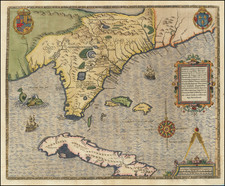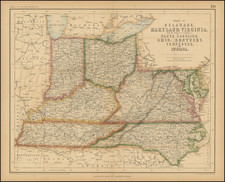A nice example of Sayer & Bennett's edition of Evans' seminal map. Along with John Mitchell's map of North America, Evans map is considered the most important American map of the 18th Century. Both maps were intended to spur western expansion into the Trans-Allegheny, Ohio Valley and regions westward and in response to French encroachments. Evans' map became the standard for nearly 50 years, being re-issued in this and other pirated editions by Jefferys, Bowles, Kitchen and others. The map is a milestone both for its political significance and extension of cartographic knowledge in the region. Governor Pownall re-issued an updated edition of the map taken from the original Evans plate, with and addition of New England and a group of tables, naming townships in the Colonies. Pownall had been a great supporter of Evans and pledged the proceeds from the map to Evans' daughter. The cartographic importance of the map and its place in the history of cartography are substantial. An essay on this map is available by emailing us a request. This example is from Jeffery's American Military Pocket Atlas, otherwise known as the Holster Atlas, having been carried into battle by British Soldiers. It has been flattened and laid on Japan paper, with the usual fold splits which occur in this atlas. Still, a nice example of this hard to find state of map. Stevens & Tree 30(g).
Lewis Evans was a land surveyor and map maker who produced one of the most influential American maps of the eighteenth-century, “A general map of the Middle British Colonies” (1755). Evans was born near Pwllheli, Caernarvonshire, Wales and emigrated to the North American colonies in 1731. He found work in Philadelphia as a clerk to no less than Benjamin Franklin, who also published several of his works including the cartographic memoir that accompanied the 1755 map and a 1749 map of Pennsylvania, New Jersey, New York and Delaware. Evans was outspoken and politically active, a combination that landed him in prison in New York for libel against the Governor of Pennsylvania, Robert Hunter Morris. He died there on June 12, 1756, leaving behind a daughter, Amelia.
Amelia’s godmother was Franklin’s wife, Deborah, who raised the girl after Evans’ death. Part of Amelia’s inheritance was the plate of the 1755 map. The rest of his maps and instruments were sold at auction in early 1760. Benjamin Franklin later arranged for the plate to be sent to John Almon for reprinting in an attempt to support Amelia. This resulted in the 1776 Pownall edition of the map; however, sales were not as expected, leaving Amelia short of funds.
Sayer & Bennett refers to the partnership of Robert Sayer (ca. 1724-1794) and John Bennett (fl. 1760-d.1787), which lasted between 1774 and 1783. Bennett had been Sayer’s apprentice. The pair specialized in American atlases, based on the work of Thomas Jefferys, who plates had been acquired by Sayer when Jefferys went bankrupt in 1766. They also began publishing navigational charts in the 1780s and quickly became the largest supplier of British charts in the trade. However, in 1783 Bennett lost control of his mental faculties and the partnership dissolved as a result. Sayer’s business was later passed to his employees, Robert Laurie and James Whittle.









![[The First Maps Printed Color] Cartes en Couleur des Lieux Sujets aux tremblements de Terre Dans toutes les parties du Monde Selon le Sisteme de l’impulsion Solaire](https://storage.googleapis.com/raremaps/img/small/52293op.jpg)


![[Rare First State] Novissima Tabula Regionis Ludovicianae Gallice dictae la Louisiane . . .](https://storage.googleapis.com/raremaps/img/small/72622.jpg)
![[First Map of the Mississippi River] Carte de la decouverte faite l'an dans l'Amerique Septentrionale](https://storage.googleapis.com/raremaps/img/small/93571.jpg)
